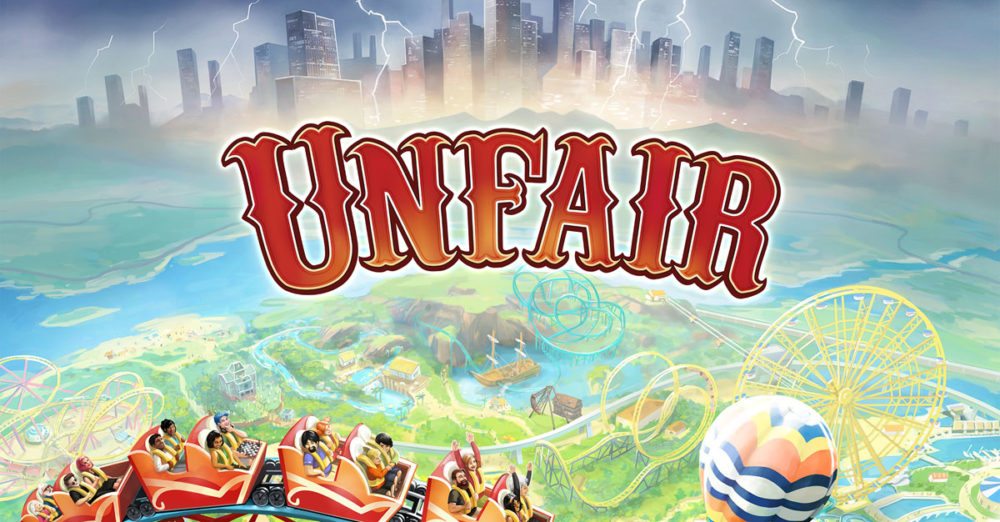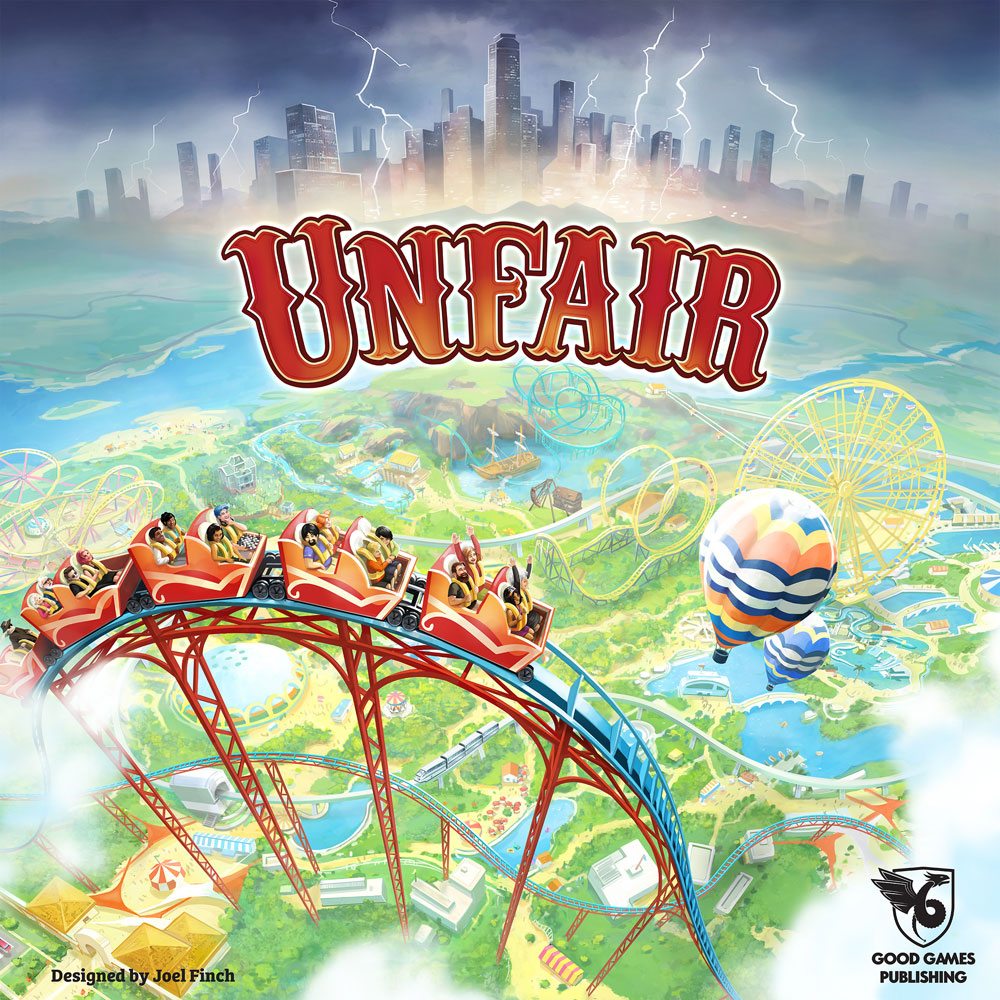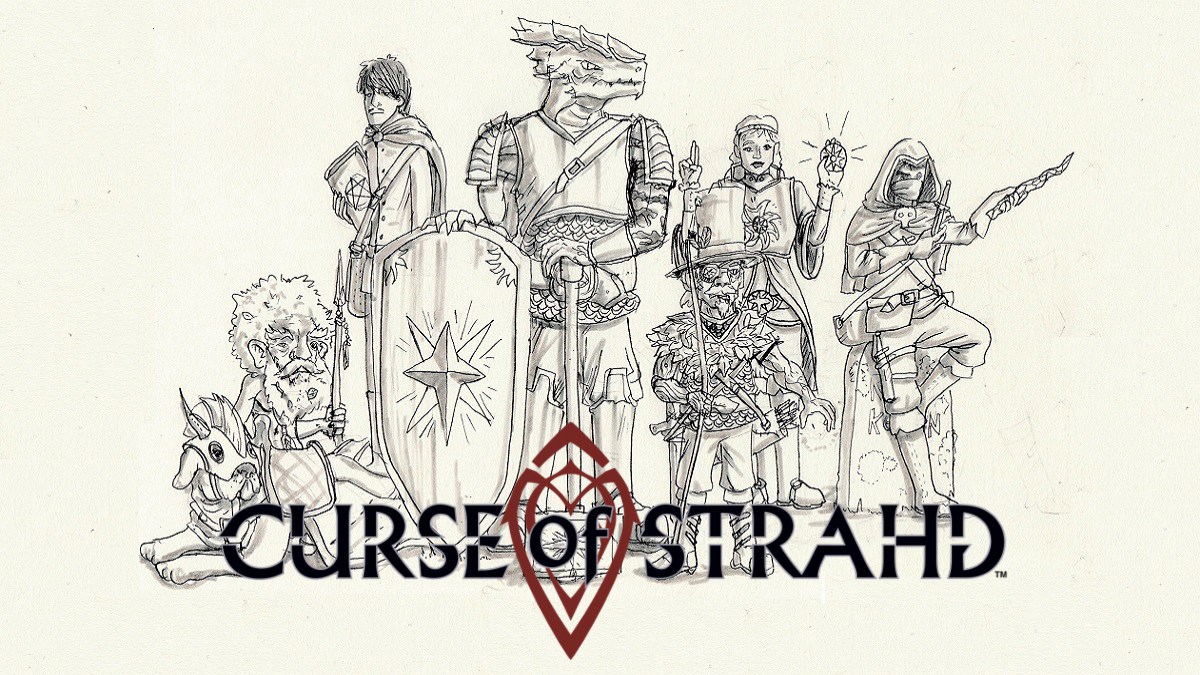Amusement parks are all about fun and good times … on the surface. But behind the scenes, there are safety standards, zoning regulations, bribery, and other shady dealings to grease the wheels of that sky-high roller coaster. It turns out the business of running a funfair can be a bit Unfair.
At a glance: Unfair is a game by Joel Finch for 2 to 4* players, ages 12 and up, and takes about 25 minutes per player. It’s already funded on Kickstarter and has been hitting stretch goals, with a pledge of $49 for a copy of the game plus stretch goals. (Special note to our Aussie readers: Good Games Publishing is based in Australia, so they’re offering free shipping to Australia and New Zealand!) The game has a lot of “take-that,” plus some fairly cynical humor about theme parks; the age rating seems about appropriate to me based on the thematic content, somewhat vicious player interaction, and resource management.
*The Kickstarter has reached a stretch goal to add the Ninja theme, which also expands the game to up to 5 players.
New to Kickstarter? Check out our crowdfunding primer.
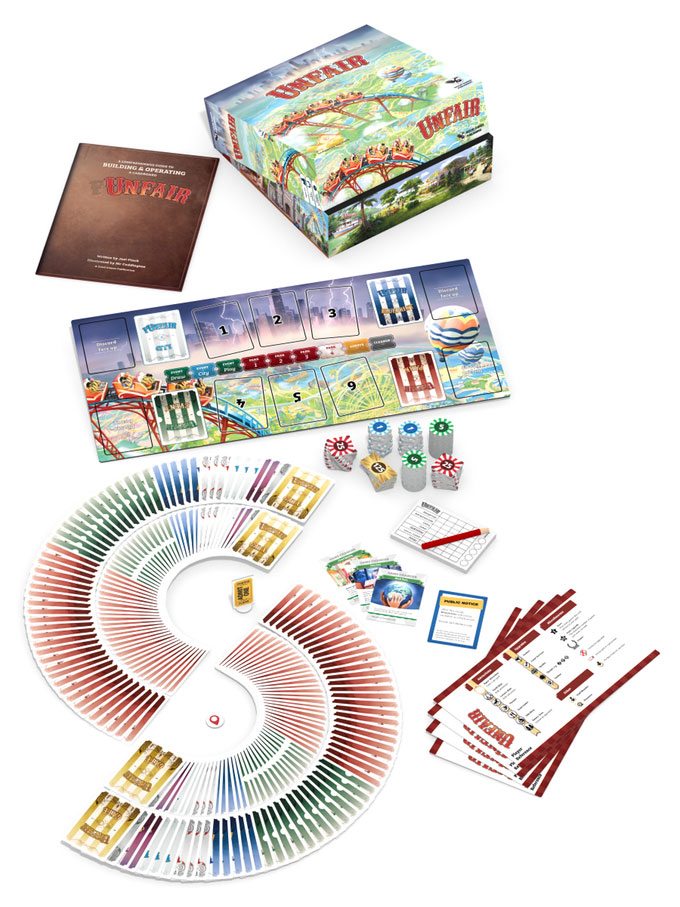
Components
- 1 game board
- 4 Theme packs of cards (56 cards each)
- 4 Player Reference sheets
- 82 coin tokens (1, 5, 25, and 125 denominations)
- 1 Starting Player marker
- 1 Current Step marker
- 1 City Planning Closure card
- 3 Game Changer cards
- 1 score pad
Note that since this game is still currently on Kickstarter, the components are still subject to change due to stretch goals. For instance, this list above is what is listed in the rulebook, but I know stretch goals have already added a 5th theme pack (and, presumably, a 5th player reference sheet), plus a few other promo cards and a double-sided board. My review is based on a pre-production prototype with the 4 theme packs. (The image above shows a little golf pencil but it wasn’t listed in the rulebook.)
Each theme pack includes:
- 1 Theme overview card
- 1 Main Gate card
- 1 Loan Marker card
- 3 “Funfair” City Event cards
- 3 “Unfair” City Event cards
- 5 Blueprint cards
- 13 Event cards
- 27 Park cards
- 2 Showcase cards
The four themes included are Robots, Pirates, Vampires, and Jungle. The 5th unlocked theme (which will be included for Kickstarter backers) is Ninja, and Good Games has mentioned that it has many other themes already in development, which will likely be released as expansion packs later on.
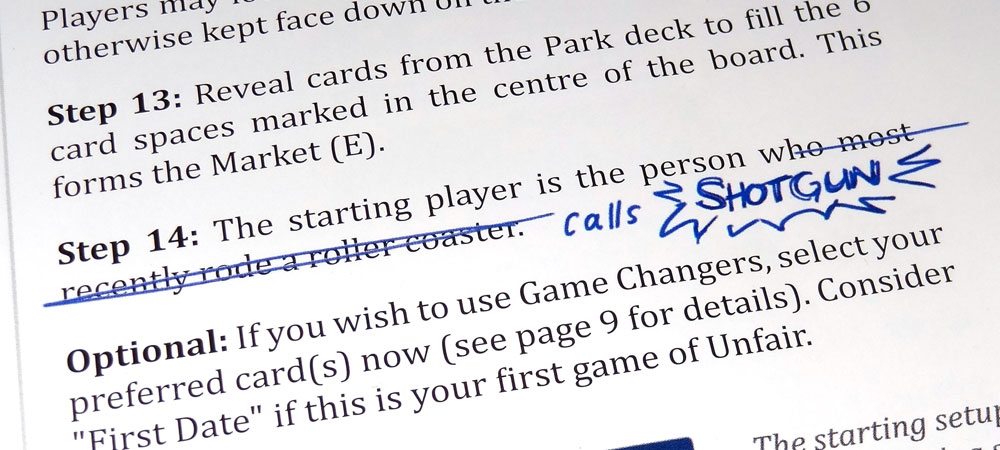
The artwork on the game is primarily by Mr. Cuddington, with additional illustrations by Philippe Poirer, and I really love it. It’s mostly realistic (particularly the theme park attractions) but there are also nice little touches of humor. Most of the cards also have flavor text on them, which is incidental to the game but really adds a lot of humor. Even the rulebook itself is pretty funny—it’s made to look like somebody went through it with a blue pen and scribbled their own notes and doodled on people’s faces.
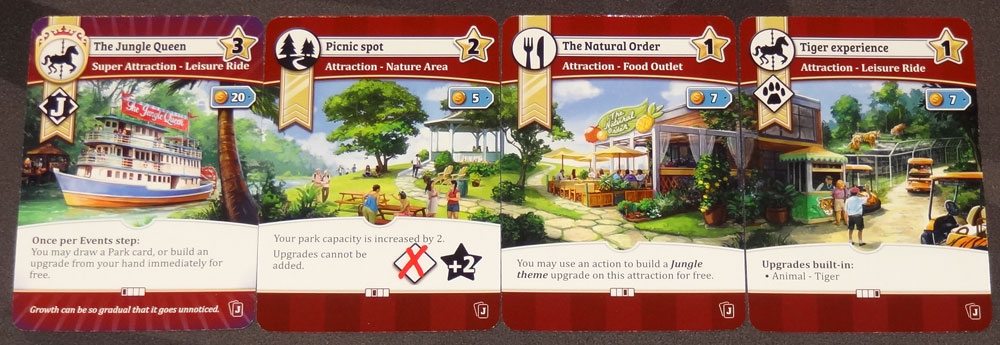
One other nice touch: each theme’s Park cards has one set of cards that will form a panorama if you line them up. There’s no game effect for doing so, but if you happen to collect all these particular attractions from a single theme, they form a picture. The four panoramas also form the four sides of the bottom half of the game box.
Everything else about the game, even in this pre-production copy, is quite nice and polished, so I’m fairly certain that the finished product will be excellent.
How to Play
You can download the rules as well as a free Print and Play version here.
The goal of the game is to score the most points by the end of eight rounds through building big attractions, fulfilling blueprints, or just earning piles of cash.
To set up, you’ll include one theme pack per player (some recommendations are listed in the rulebook), and then shuffle together the cards of each type to form decks. (For instance, take all the Park cards from the selected themes and combine them into one Park deck.) The Park, Event, and Blueprint cards go onto the appropriate spaces on the board. The City Event deck has a special setup: it will be 4 “Unfair” cards, then the City Planning Closure card, and then 4 “Funfair” cards on top of that. (Any other Unfair and Funfair cards are set aside without revealing them.)
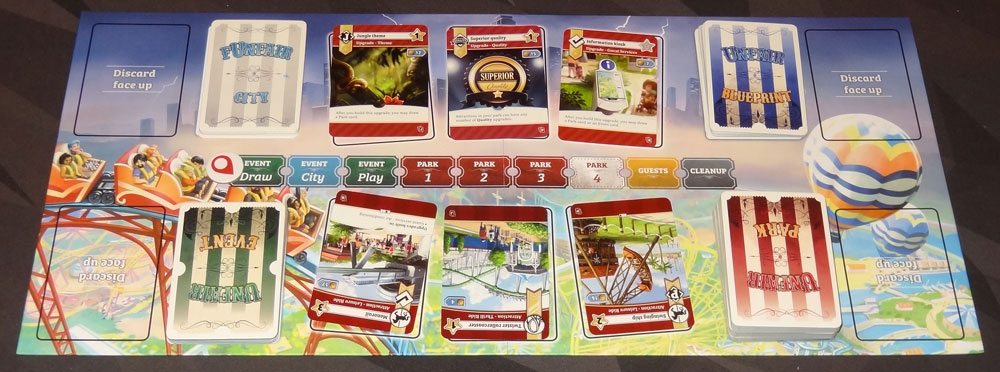
Each player will get one Main Gate, one Loan Marker card, 5 Park cards, 2 Showcase cards, and $20. Then reveal the top 6 Park cards into the Market spaces on the board. The Main Gate goes in front of you, and the Loan card is set face-down. All your other cards are kept secret from other players. Pick a starting player and give them the Starting Player token.
The Loan card can be used to track how much money you borrowed from the bank—for each 5 coins you borrow, you will lose 10 points at the end of the game. Loans may not be paid off early, so if you borrow coins, you will be paying the penalty.
Each round has several steps, in this order (use the Current Step marker to track the phases on the board):
- Draw Events – Each player draws one Event card.
- City Event – Reveal and resolve the City Event card.
- Play Events – Players may play Event cards and use “Event step” abilities.
- Park 1 – Draw, Build, Demolish, or Pick Up Loose Change.
- Park 2
- Park 3
- Park 4 (only with special abilities)
- Guests – Earn money based on your park’s star value.
- Cleanup – discard cards, refresh Market.

During the first half of the game, the blue “Funfair” City Events will generally be helpful; in the second half, the red “Unfair” cards will be harmful. In the middle, there’s a closure reminder card—it indicates the last round where you can take Blueprints as a Draw action, and after that the card is flipped over to the “Sorry, we’re closed” side and put on the Blueprints deck.

During the Play Events step, players may use Event cards and abilities or pass, one at a time in turn order. The step ends once everyone has passed in order—however, if you pass and it becomes your turn again, you may play a card later, as long as not everyone has passed yet. Most Event cards have two halves: the top helps you, the bottom harms somebody else. You get to choose which to use.

The Park phase is where you will get more cards and build up your amusement park. During each Park step, you may take a single action: Draw, Build, Demolish, or Pick Up Loose Change.
Draw: You may draw from the Park, Event, and Blueprint decks—as an action, draw two and discard one. (For Blueprints, you may discard both if you wish.) You may also discard a Park or Event card from your hand to draw 5 Park cards and keep one, discarding the rest. Also, you may use a Draw action to pick up any single face-up card from the Market.
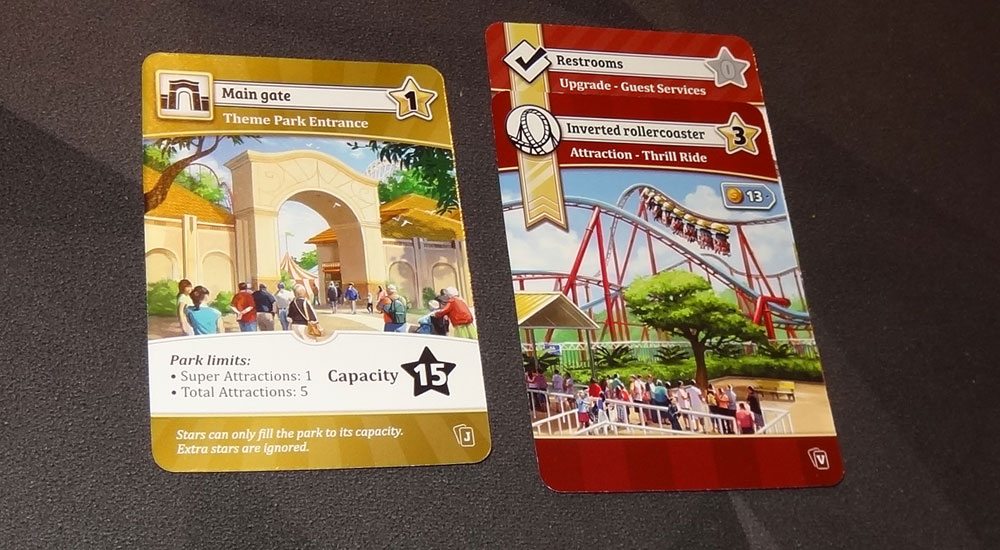
Build: Simply pay the cost shown on the card and place the card face-up in your area. You may build either from your hand or directly from the Market. You may have up to 5 attractions in your park, placed to the right of your Main Gate. Resources and Staff Members are placed to the left of the Main gate. Upgrades are placed on attractions, layered behind them so that you can see the icons and star value of the upgrades splayed out behind each attraction. You can have any number of upgrades on a single attraction, but never more than two with the exact same name. (Some attractions have special abilities that take effect when built, and some have restrictions on where they can be built.) You may only build one Super Attraction in your park, and only after your park has reached a 5-star value.
Demolish: You may demolish any single card from your park by discarding it. If you demolish an attraction, all upgrades on that attraction are also discarded. You don’t get anything in return for demolishing things.
Pick Up Loose Change: Count your total number of attractions (even closed ones) and take that many coins from the bank.
Generally, each player will only get 3 Park actions total, but there are some abilities that will give you a 4th action.

In the Guests phase, you earn money as guests come to your park. Add up all of your star values in your park, but do not count closed attractions or their upgrades. Check for any events or abilities that add extra stars: that’s the total number of guests coming to your park. Your park has a capacity of 15 guests (shown on the Main Gate card), and some cards may increase your capacity, so you cannot sell tickets to guests above your capacity. You get 1 coin per guest that actually comes to your park.
Finally, in the Cleanup step, everyone discards down to 5 Park/Event cards, the Market is discarded and replenished, and any Event cards still in play are discarded. If you have face-down cards in your park, turn them face-up. Finally, pass the Starting Player marker to the next player, and start a new round.
The game ends after 8 rounds (when all the City Events have been used up).

To score, you consult the chart for your attraction size: each icon in the attraction’s ribbon will increase its score. You get points for Staff Members in your park, as shown on the cards. Reveal your Blueprints: you score points if you completed the Required section on them, but lose points if you don’t. Some Blueprints also include a Bonus section, which can award more points if the Required section was completed. You also get 1 point for every 2 coins you have at the end of the game. Finally, deduct any points required for loans.
Highest score wins; tie goes to the largest star total, then the largest number of blueprints, then the most cash.

The Verdict
I hadn’t known about Unfair before Gen Con, but when I went to the Good Games booth to pick up a copy of Monstrous, they had some tables set up to run demos of Unfair. I have to admit: the artwork was what caught my eye at first, because it just looks so polished, but as I learned a little more about the game, I was really intrigued. They sent me home with one of the pre-production copies, and I’ve gotten to play it a couple of times since then.
I’ve really been enjoying it, even though I feel like I’ve only just scratched the surface of the gameplay. My strategy so far has been to go for Blueprints, but my parks have not been particularly profitable and I haven’t made a lot of cash.
But I do like that there are various approaches you can take: you can go for a huge pile of upgrades, because each additional upgrade is worth even more points than the one before. Or you can go for Blueprints, which are a bit like the Route cards in Ticket to Ride: you might grab one that you’ve already completed, in which case you just got some free points! But if you keep a Blueprint and don’t finish it by the end of the game, it’ll cost you 10 points. Hiring Staff Members will give you access to special abilities and end-game points, but only if you manage to retain them until the end. (Watch out for Head Hunting and Frivolous Lawsuits!)
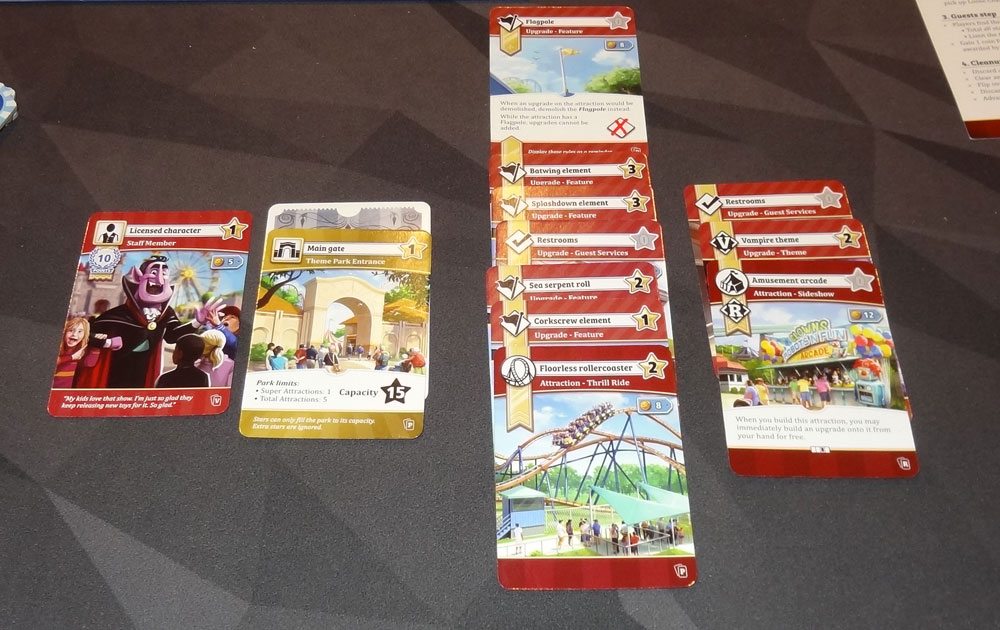
There’s an interesting balance between building up and building out. If you have more attractions, you’ll get more money when you pick up loose change, and most (but not all) attractions have a few stars on them, so you’ll earn money during the guest phase. But unless you have a Blueprint that rewards you, having many small attractions doesn’t score nearly as many points as one really big attraction. On the other hand, diversifying also helps protect you from events that may shut down all of one type of attraction for a round. Many upgrades have no star value whatsoever, so they won’t make back any money for you—they’re strictly for scoring points, both through the size bonus and Blueprints.
I really like the way the themes work: each theme has its own mix of events, attractions, and effects. For instance, the Jungle theme is all about the leisure rides, and focuses on expanding your park capacity. The Robot theme is all about upgrades: there are many effects that let you build upgrades for free. There are some events that are common across multiple themes, but each theme also has some that are specific to it. Becoming familiar with the various themes and which types of events are in each deck could also direct your strategy somewhat, though that certainly gets into more advanced play.
The one downside to the themes is that setting up and putting Unfair away can take a little longer. Each card has a little icon in the bottom left corner so you can sort them out by theme. But then, either when you put it away or when you set it up, you’ll have to take each theme, separate it into the different types of cards (Park, Event, City Event, Blueprint, etc.) and shuffle them together. It can take some time to do, and there’s no easy way around it.

Game Changer cards let you tweak the game a little for a different feel. “First Date” shortens the game and removes Showcase cards and the harder Blueprint cards. (I like keeping the Showcase cards in but using the rest of the rules for first-timers.) “World Peace” is for those who don’t want any “take that”: you can’t use abilities that affect other players, so instead of attacking each other, you just focus on building your own park. “Grand Opening” is for those who want to jump right into all of the powers: the player to your left picks one of your two Showcase cards—that one is automatically built in your park. That variant means that everyone starts off with some special ability (granted by the Showcase) plus one of the most expensive cards pre-built. While the Game Changers aren’t strictly necessary, I do appreciate the way that you can adjust the game based on who’s playing.
Overall, I’ve really been enjoying Unfair and I think it’s an excellent game. Although the rulebook may seem a little daunting, it’s mostly because it provides a lot of details about all the cards—the gameplay itself is actually pretty easy, and once everyone understands the available options, the game actually can move fairly quickly. If you like theme parks (and especially if you like playing mean), Unfair is worth the ticket price.
Visit the Unfair Kickstarter page to back the project!
Disclosure: I received a pre-production version of this game for review.
